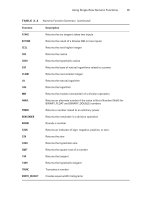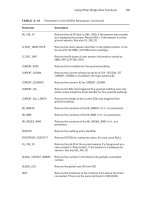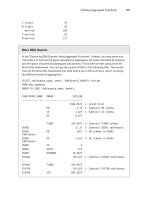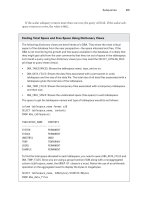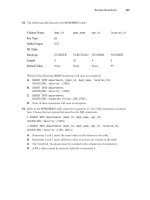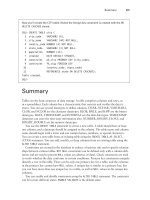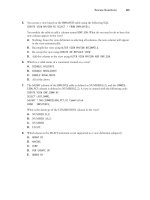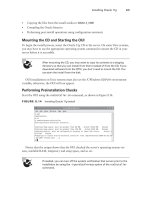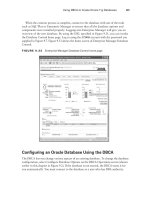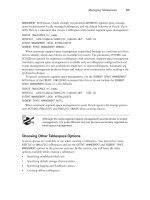Tài liệu OCA: Oracle Database 11g Administrator Certified Associate Study Guide- P7 ppt
Bạn đang xem bản rút gọn của tài liệu. Xem và tải ngay bản đầy đủ của tài liệu tại đây (615.96 KB, 50 trang )
Subqueries
231
If the scalar subquery returns more than one row, the query will fail. If the scalar sub-
query returns no rows, the value is
NULL
.
Finding Total Space and Free Space Using Dictionary Views
The following dictionary views are best friends of a DBA. They show the most critical
aspect of the database from the user perspective—the space allocated and free. If the
DBA is not monitoring the growth and free space available in the database, it is likely that
they might get calls from the user community that they ran out of space in the tablespace.
Let’s build a query using four dictionary views (you may need the
SELECT_CATALOG_ROLE
privilege to query these views).
DBA_TABLESPACES
ÛN
: Shows the tablespace name, type, and so on.
DBA_DATA_FILES
ÛN
: Shows the data files associated with a permanent or undo
tablespace and the size of the data file. The total size of all data files associated with a
tablespace gives the total size of the tablespace.
DBA_TEMP_FILES
ÛN
: Shows the temporary files associated with a temporary tablespace
and their size.
DBA_FREE_SPACE
ÛN
: Shows the unallocated space (free space) in each tablespace.
The query to get the tablespace names and type of tablespace would be as follows:
column tablespace_name format a18
SELECT tablespace_name, contents
FROM dba_tablespaces;
TABLESPACE_NAME CONTENTS
------------------ ---------
SYSTEM PERMANENT
SYSAUX PERMANENT
UNDOTBS1 UNDO
TEMP TEMPORARY
USERS PERMANENT
EXAMPLE PERMANENT
To find the total space allocated to each tablespace, you need to query
DBA_DATA_FILES
and
DBA_TEMP_FILES
. Since you are using a group function (
SUM
) along with a nonaggregated
column (
tablespace_name
), the
GROUP BY
clause is a must. Notice the use of an arithmetic
operation on the aggregated result to display the bytes in megabytes.
SELECT tablespace_name, SUM(bytes)/1048576 MBytes
FROM dba_data_files
95127c04.indd 231 2/18/09 9:43:39 AM
Please purchase PDF Split-Merge on www.verypdf.com to remove this watermark.
232
Chapter 4
N
Using Joins and Subqueries
GROUP BY tablespace_name;
TABLESPACE_NAME MBYTES
------------------ ----------
UNDOTBS1 730
SYSAUX 800.1875
USERS 201.75
SYSTEM 710
EXAMPLE 100
SELECT tablespace_name, SUM(bytes)/1048576 MBytes
FROM dba_temp_files
GROUP BY tablespace_name;
TABLESPACE_NAME MBYTES
------------------ ----------
TEMP 50.0625
You can find the total free space in each tablespace using the
DBA_FREE_SPACE
view.
Notice that the free space from temporary tablespace is not shown in this query.
SELECT tablespace_name, SUM(bytes)/1048576 MBytesFree
FROM dba_free_space
GROUP BY tablespace_name;
TABLESPACE_NAME MBYTESFREE
------------------ ----------
SYSAUX 85.25
UNDOTBS1 718.6875
USERS 180.4375
SYSTEM 8.3125
EXAMPLE 22.625
Let’s now try to display the total size of the tablespaces and their free space side-by-side
using a
UNION ALL
query.
UNION ALL
is used to avoid sorting.
UNION
will produce the
same result.
SELECT tablespace_name, SUM(bytes)/1048576 MBytes, 0 MBytesFree
FROM dba_data_files
GROUP BY tablespace_name
UNION ALL
SELECT tablespace_name, SUM(bytes)/1048576 MBytes, 0
FROM dba_temp_files
95127c04.indd 232 2/18/09 9:43:39 AM
Please purchase PDF Split-Merge on www.verypdf.com to remove this watermark.
Subqueries
233
GROUP BY tablespace_name
UNION ALL
SELECT tablespace_name, 0, SUM(bytes)/1048576
FROM dba_free_space
GROUP BY tablespace_name;
TABLESPACE_NAME MBYTES MBYTESFREE
------------------ ---------- ----------
UNDOTBS1 730 0
SYSAUX 800.1875 0
USERS 201.75 0
SYSTEM 710 0
EXAMPLE 100 0
TEMP 50.0625 0
SYSAUX 0 85.25
UNDOTBS1 0 718.6875
USERS 0 180.4375
SYSTEM 0 8.3125
EXAMPLE 0 22.625
You got the result, but it’s not exactly as you expected. You want to see the free-space
information beside each tablespace. Let’s join the results of the total space with the free
space and see what happens. Here you are creating two subqueries (inline views
total-
space
and
freespace
) and joining them together using the
tablespace_name
column.
SELECT tablespace_name, MBytes, MBytesFree
FROM
(SELECT tablespace_name, SUM(bytes)/1048576 MBytes
FROM dba_data_files
GROUP BY tablespace_name
UNION ALL
SELECT tablespace_name, SUM(bytes)/1048576 MBytes
FROM dba_temp_files
GROUP BY tablespace_name) totalspace
JOIN
(SELECT tablespace_name, 0, SUM(bytes)/1048576 MBytesFree
FROM dba_free_space
GROUP BY tablespace_name) freespace
USING (tablespace_name);
95127c04.indd 233 2/18/09 9:43:39 AM
Please purchase PDF Split-Merge on www.verypdf.com to remove this watermark.
234
Chapter 4
N
Using Joins and Subqueries
TABLESPACE_NAME MBYTES MBYTESFREE
------------------ ---------- ----------
SYSAUX 800.1875 85.25
UNDOTBS1 730 718.6875
USERS 201.75 180.4375
SYSTEM 710 8.3125
EXAMPLE 100 22.625
You are almost there; the only item missing is information about the temporary tablespace.
Since the temporary-tablespace free-space information is not included in the
freespace
subquery and you used an
INNER
join condition, the result set did not include temporary
tablespaces. Now if you change the
INNER JOIN
to an
OUTER JOIN
, you get the desired
result:
SELECT tablespace_name, MBytes, MBytesFree
FROM
(SELECT tablespace_name, SUM(bytes)/1048576 MBytes
FROM dba_data_files
GROUP BY tablespace_name
UNION ALL
SELECT tablespace_name, SUM(bytes)/1048576 MBytes
FROM dba_temp_files
GROUP BY tablespace_name) totalspace
LEFT OUTER JOIN
(SELECT tablespace_name, 0, SUM(bytes)/1048576 MBytesFree
FROM dba_free_space
GROUP BY tablespace_name) freespace
USING (tablespace_name)
ORDER BY 1;
TABLESPACE_NAME MBYTES MBYTESFREE
------------------ ---------- ----------
EXAMPLE 100 22.625
SYSAUX 800.1875 85.0625
SYSTEM 710 8.3125
TEMP 50.0625
UNDOTBS1 730 718.6875
USERS 201.75 180.4375
95127c04.indd 234 2/18/09 9:43:39 AM
Please purchase PDF Split-Merge on www.verypdf.com to remove this watermark.
Subqueries
235
Another method to write the same query would be to use the query you built earlier and
aggregate its result using an outer query, as shown here:
SELECT tsname, sum(MBytes) MBytes, sum(MBytesFree) MBytesFree
FROM (
SELECT tablespace_name tsname, SUM(bytes)/1048576 MBytes, 0 MBytesFree
FROM dba_data_files
GROUP BY tablespace_name
UNION ALL
SELECT tablespace_name, SUM(bytes)/1048576 MBytes, 0
FROM dba_temp_files
GROUP BY tablespace_name
UNION ALL
SELECT tablespace_name, 0, SUM(bytes)/1048576
FROM dba_free_space
GROUP BY tablespace_name)
GROUP BY tsname
ORDER BY 1;
TSNAME MBYTES MBYTESFREE
------------------------------ ---------- ----------
EXAMPLE 100 22.625
SYSAUX 800.1875 85.0625
SYSTEM 710 8.3125
TEMP 50.0625 0
UNDOTBS1 730 718.6875
USERS 201.75 180.4375
Multiple-Column Subqueries
A subquery is multiple-column when you have more than one column in the
SELECT
clause
of the subquery. Multiple-column subqueries are generally used to compare column condi-
tions or in an
UPDATE
statement. Let’s consider a simple example using the
STATE
and
CITY
tables shown here:
SQL> SELECT * FROM state;
CNT_CODE ST_CODE ST_NAME
---------- ------- ------------
1 TX TEXAS
1 CA CALIFORNIA
95127c04.indd 235 2/18/09 9:43:40 AM
Please purchase PDF Split-Merge on www.verypdf.com to remove this watermark.
236
Chapter 4
N
Using Joins and Subqueries
91 TN TAMIL NADU
1 TN TENNESSE
91 KL KERALA
SQL> SELECT * FROM city;
CNT_CODE ST_CODE CTY_CODE CTY_NAME
---------- ------- -------- --------------
1 TX 1001 DALLAS
91 TN 2243 MADRAS
1 CA 8099 LOS ANGELES
List the cities in Texas using a subquery on the
STATE
table:
SELECT cty_name
FROM city
WHERE (cnt_code, st_code) IN
(SELECT cnt_code, st_code
FROM state
WHERE st_name = ‘TEXAS’);
CTY_NAME
----------
DALLAS
Subqueries in Other DML Statements
You can use subqueries in DML statements such as
INSERT
,
UPDATE
,
DELETE
, and
MERGE
. DML
statements and their syntax are discussed in Chapter 5, “Manipulating Data.” The following
are some examples of subqueries in DML statements:
To update the salary of all employees to the maximum salary in the corresponding
ÛN
department (correlated subquery), use this:
UPDATE employees e1
SET salary = (SELECT MAX(salary)
FROM employees e2
WHERE e1.department_id = e2.department_id);
To delete the records of employees whose salary is less than the average salary in the
ÛN
department (using a correlated subquery), use this:
DELETE FROM employees e
WHERE salary < (SELECT AVG(salary) FROM employees
WHERE department_id = e.department_id);
95127c04.indd 236 2/18/09 9:43:40 AM
Please purchase PDF Split-Merge on www.verypdf.com to remove this watermark.
Subqueries
237
To insert records to a table using a subquery, use this:
ÛN
INSERT INTO employee_archive
SELECT * FROM employees;
To specify a subquery in the
ÛN
VALUES
clause of the
INSERT
statement, use this:
INSERT INTO departments
(department_id, department_name)
VALUES ((SELECT MAX(department_id)
+10 FROM departments), ‘EDP’);
You can also have a subquery in the
INSERT
,
UPDATE
, and
DELETE
statements in place of
the table name. Here is an example:
DELETE FROM
(SELECT * FROM departments
WHERE department_id < 20)
WHERE department_id = 10;
The subquery can have an optional
WITH
clause.
WITH READ ONLY
specifies that the subquery
cannot be updated.
WITH CHECK OPTION
specifies that if the subquery is used in place of a table
in an
INSERT
,
UPDATE
, or
DELETE
statement, Oracle will not allow any changes to the table that
would produce rows that are not included in the subquery. Let’s look at an example:
INSERT INTO (SELECT department_id, department_name
FROM departments
WHERE department_id < 20)
VALUES (35, ‘MARKETING’);
1 row created.
INSERT INTO (SELECT department_id, department_name
FROM departments
WHERE department_id < 20 WITH CHECK OPTION)
VALUES (45, ‘EDP’)
SQL> /
FROM departments
*
ERROR at line 2:
ORA-01402: view WITH CHECK OPTION where-clause violation
SQL>
95127c04.indd 237 2/18/09 9:43:40 AM
Please purchase PDF Split-Merge on www.verypdf.com to remove this watermark.
238
Chapter 4
N
Using Joins and Subqueries
Summary
In this chapter, you learned to retrieve data from multiple tables. I started off discussing
table joins. You also learned how to use subqueries and set operators.
Joins are used to relate two or more tables (or views). In a relational database, it is com-
mon to have a requirement to join data. The tables are joined by using a common column
in the tables in the
WHERE
clause of the query. Oracle supports ISO/ANSI SQL1999 syntax
for joins. Using this syntax, the tables are joined using the
JOIN
keyword, and a condition
can be specified using the
ON
clause.
If the join condition uses the equality operator (
=
or
IN
), it is known as an equality join.
If any other operator is used to join the tables, it is a nonequality join. If you do not specify
any join condition between the tables, the result will be a Cartesian product: each row from
the first table joined to every row in the second table. To avoid Cartesian joins, there should
be at least n-1 join conditions in the
WHERE
clause when there are n tables in the
FROM
clause.
A table can be joined to itself. If you want to select the results from a table, even if there
are no corresponding rows in the joined table, you can use the outer join operator:
(+)
. In
the ANSI syntax, you can use the
NATURAL JOIN
,
CROSS JOIN
,
LEFT JOIN
,
RIGHT JOIN
, and
FULL JOIN
keywords to specify the type of join.
A subquery is a query within a query. Writing subqueries is a powerful way to manipu-
late data. You can write single-row and multiple-row subqueries. Single-row subqueries
must return zero or one row; multiple-row subqueries return zero or more rows.
IN
and
EXISTS
are the most commonly used subquery operators. Subqueries can appear in the
WHERE
clause or in the
FROM
clause. They can also replace table names in
SELECT
,
DELETE
,
INSERT
, and
UPDATE
statements. Subqueries that return one row and one column result are
known as scalar subqueries. Scalar subqueries can be used in most places where you would
use an expression.
Set operators are used to combine the results of more than one query into one. Each
query is separate and will work on its own. Four set operators are available in Oracle:
UNION
,
UNION ALL
,
MINUS
, and
INTERSECT
.
Exam Essentials
Understand joins. Make sure you know the different types of joins. Understand the differ-
ence between natural, cross, simple, complex, and outer joins.
Know the different outer join clauses. You can specify outer joins using
LEFT
,
RIGHT
, or
FULL
. Know the syntax of each type of join.
Be sure of the join syntax. Spend time practicing each type of join using the ANSI syntax.
Understand the restrictions of using each ANSI keyword in the
JOIN
and their implied
column-naming conventions.
95127c04.indd 238 2/18/09 9:43:40 AM
Please purchase PDF Split-Merge on www.verypdf.com to remove this watermark.
Exam Essentials
239
Know how to write subqueries. Understand the use and flexibility of subqueries. Practice
using scalar subqueries and correlated subqueries.
Understand the use of the
ORDER BY
clause in the subqueries. You can use the
ORDER BY
clause in all subqueries, except the subqueries appearing in the
WHERE
clause of the query.
You can use the
GROUP BY
clause in the subqueries.
Know the set operators. Understand the set operators that can be used in compound
queries. Know the difference between the
UNION
and
UNION ALL
operators.
Understand where you can specify the
ORDER BY
clause when using set operators. When
using set operators to join two or more queries, the
ORDER BY
clause can appear only at the
very end of the query. You can specify the column names as they appear in the top query or
use positional notation.
95127c04.indd 239 2/18/09 9:43:40 AM
Please purchase PDF Split-Merge on www.verypdf.com to remove this watermark.
240
Review Questions
Review Questions
1. Which line of code has an error?
A. SELECT dname, ename
B. FROM emp e, dept d
C. WHERE emp.deptno = dept.deptno
D. ORDER BY 1, 2;
2. What will be the result of the following query?
SELECT c.cust_id, c.cust_name, o.ord_date, o.prod_id
FROM customers c, orders o
WHERE c.cust_id = o.cust_id (+);
A. List all the customer names in the CUSTOMERS table and the orders they made from the
ORDERS table, even if the customer has not placed an order.
B. List only the names of customers from the CUSTOMERS table who have placed an order
in the ORDERS table.
C. List all orders from the ORDERS table, even if there is no valid customer record in the
CUSTOMERS table.
D. For each record in the CUSTOMERS table, list the information from the ORDERS table.
3. The CUSTOMERS and ORDERS tables have the following data:
SQL> SELECT * FROM customers;
CUST_ CUST_NAME PHONE CITY
----- -------------------- --------------- -----------
A0101 Abraham Taylor Jr. Fort Worth
B0134 Betty Baylor 972-555-5555 Dallas
B0135 Brian King Chicago
SQL> SELECT * FROM orders;
ORD_DATE PROD_ID CUST_ID QUANTITY PRICE
--------- ---------- ------- ---------- ----------
20-FEB-00 1741 B0134 5 65.5
02-FEB-00 1001 B0134 25 2065.85
02-FEB-00 1001 B0135 3 247.9
When the following query is executed, what will be the value of PROD_ID and ORD_DATE for
the customer Abraham Taylor Jr.?
SELECT c.cust_id, c.cust_name, o.ord_date, o.prod_id
FROM customers c, orders o
WHERE c.cust_id = o.cust_id (+);
95127c04.indd 240 2/18/09 9:43:40 AM
Please purchase PDF Split-Merge on www.verypdf.com to remove this watermark.
Review Questions
241
A. NULL, 01-JAN-01
B. NULL, NULL
C. 1001, 02-FEB-00
D. The query will not return customer Abraham Taylor Jr.
4. When using ANSI join syntax, which clause is used to specify a join condition?
A. JOIN
B. USING
C. ON
D. WHERE
5. The EMPLOYEES table has EMPLOYEE_ID, DEPARTMENT_ID, and FULL_NAME columns. The
DEPARTMENTS table has DEPARTMENT_ID and DEPARTMENT_NAME columns. Which two of the
following queries return the department ID, name, and employee name, listing department
names even if there is no employee assigned to that department? (Choose two.)
A. SELECT d.department_id, d.department_name, e.full_name
FROM departments d
NATURAL LEFT OUTER JOIN employees e;
B. SELECT department_id, department_name, full_name
FROM departments
NATURAL LEFT JOIN employees;
C. SELECT d.department_id, d.department_name, e.full_name
FROM departments d
LEFT OUTER JOIN employees e
USING (d.department_id);
D. SELECT d.department_id, d.department_name, e.full_name
FROM departments d
LEFT OUTER JOIN employees e
ON (d.department_id = e.department_id);
6. Which two operators are not allowed when using an outer join operator in the query?
(Choose two.)
A. OR
B. AND
C. IN
D. =
7. Which SQL statements do not give an error? (Choose all that apply.)
A. SELECT last_name, e.hire_date, department_id
FROM employees e
JOIN (SELECT max(hire_date) max_hire_date
FROM employees ORDER BY 1) me
ON (e.hire_date = me.max_hire_date)
95127c04.indd 241 2/18/09 9:43:40 AM
Please purchase PDF Split-Merge on www.verypdf.com to remove this watermark.
242
Review Questions
B. SELECT last_name, e.hire_date, department_id
FROM employees e
WHERE hire_date =
(SELECT max(hire_date) max_hire_date
FROM employees ORDER BY 1)
C. SELECT last_name, e.hire_date, department_id
FROM employees e
WHERE (department_id, hire_date) IN
(SELECT department_id, max(hire_date) hire_date
FROM employees GROUP BY department_id)
D. SELECT last_name, e.hire_date, department_id
FROM employees e JOIN
(SELECT department_id, max(hire_date) hire_date
FROM employees GROUP BY department_id) me
USING (hire_date)
8. The columns of the EMPLOYEES, DEPARTMENTS, and JOBS tables are shown here:
Table Column Names Datatype
EMPLOYEES EMPLOYEE_ID
NUMBER (6)
FIRST_NAME
VARCHAR2 (25)
LAST_NAME
VARCHAR2 (25)
SALARY
NUMBER (8,2)
JOB_ID
VARCHAR2 (10)
MANAGER_ID
NUMBER (6)
DEPARTMENT_ID
NUMBER (2)
DEPARTMENTS DEPARTMENT_ID
NUMBER (2)
DEPARTMENT_NAME
VARCHAR2 (30)
MANAGER_ID
NUMBER (6)
LOCATION_ID
NUMBER (4)
JOBS JOB_ID
VARCHAR2 (10)
JOB_TITLE
VARCAHR2 (30)
Which assertion about the following query is correct?
95127c04.indd 242 2/18/09 9:43:40 AM
Please purchase PDF Split-Merge on www.verypdf.com to remove this watermark.
Review Questions
243
1 SELECT e.last_name, d.department_name, j.job_title
2 FROM jobs j
3 INNER JOIN employees e
4 ON (e.department_id = d.department_id)
5 JOIN departments d
6 ON (j.job_id = e.job_id);
A. The query returns all the rows from the EMPLOYEE table, where there is a corresponding
record in the JOBS table and the DEPARTMENTS table.
B. The query fails with an invalid column name error.
C. The query fails because line 3 specifies INNER JOIN, which is not a valid syntax.
D. The query fails because line 5 does not specify the keyword INNER.
E. The query fails because the column names are qualified with the table alias.
9. The columns of the EMPLOYEES and DEPARTMENTS tables are shown in question 8. Consider
the following three queries using those tables.
1. SELECT last_name, department_name
FROM employees e, departments d
WHERE e.department_id = d.department_id;
2. SELECT last_name, department_name
FROM employees NATURAL JOIN departments;
3. SELECT last_name, department_name
FROM employees JOIN departments
USING (department_id);
Which of the following assertions best describes the results?
A. Queries 1, 2, and 3 produce the same results.
B. Queries 2 and 3 produce the same result; query 1 produces a different result.
C. Queries 1, 2, and 3 produce different results.
D. Queries 1 and 3 produce the same result; query 2 produces a different result.
10. The data in the STATE table is as shown here:
SQL> SELECT * FROM state;
CNT_CODE ST_CODE ST_NAME
---------- ------- ------------
1 TX TEXAS
1 CA CALIFORNIA
91 TN TAMIL NADU
1 TN TENNESSE
91 KL KERALA
95127c04.indd 243 2/18/09 9:43:40 AM
Please purchase PDF Split-Merge on www.verypdf.com to remove this watermark.
244
Review Questions
Consider the following query.
SELECT cnt_code
FROM state
WHERE st_name = (SELECT st_name FROM state
WHERE st_code = ‘TN’);
Which of the following assertions best describes the results?
A. The query will return the CNT_CODE for the ST_CODE value ‘TN’.
B. The query will fail and will not return any rows.
C. The query will display 1 and 91 as CNT_CODE values.
D. The query will fail because an alias name is not used.
11. The data in the STATE table is shown in question 10. The data in the CITY table is as
shown here:
SQL> SELECT * FROM city;
CNT_CODE ST_CODE CTY_CODE CTY_NAME
---------- ------- ---------- -------------
1 TX 1001 DALLAS
91 TN 2243 MADRAS
1 CA 8099 LOS ANGELES
What is the result of the following query?
SELECT st_name “State Name”
FROM state
WHERE (cnt_code, st_code) =
(SELECT cnt_code, st_code
FROM city
WHERE cty_name = ‘DALLAS’);
A. TEXAS
B. The query will fail because CNT_CODE and ST_CODE are not in the WHERE clause of the
subquery.
C. The query will fail because more than one column appears in the WHERE clause.
D. TX
12. Which line of the code has an error?
1 SELECT department_id, count(*)
2 FROM employees
3 GROUP BY department_id
4 HAVING COUNT(department_id) =
5 (SELECT max(count(department_id))
6 FROM employees
7 GROUP BY department_id);
95127c04.indd 244 2/18/09 9:43:40 AM
Please purchase PDF Split-Merge on www.verypdf.com to remove this watermark.
Review Questions
245
A. Line 3
B. Line 4
C. Line 5
D. Line 7
E. No error
13. Which of the following is a correlated subquery?
A. select cty_name from city
where st_code in (select st_code from state
where st_name = ‘TENNESSEE’
and city.cnt_code = state.cnt_code);
B. select cty_name
from city
where st_code in (select st_code from state
where st_name = ‘TENNESSEE’);
C. select cty_name
from city, state
where city.st_code = state.st_code
and city.cnt_code = state.cnt_code
and st_name = ‘TENNESSEE’;
D. select cty_name
from city, state
where city.st_code = state.st_code (+)
and city.cnt_code = state.cnt_code (+)
and st_name = ‘TENNESSEE’;
14. The COUNTRY table has the following data:
SQL> SELECT * FROM country;
CNT_CODE CNT_NAME CONTINENT
---------- ----------------- ----------
1 UNITED STATES N.AMERICA
91 INDIA ASIA
65 SINGAPORE ASIA
What value is returned from the subquery when you execute the following?
SELECT CNT_NAME
FROM country
WHERE CNT_CODE =
(SELECT MAX(cnt_code) FROM country);
95127c04.indd 245 2/18/09 9:43:40 AM
Please purchase PDF Split-Merge on www.verypdf.com to remove this watermark.
246
Review Questions
A. INDIA
B. 65
C. 91
D. SINGAPORE
15. Which line in the following query contains an error?
1 SELECT deptno, ename, sal
2 FROM emp e1
3 WHERE sal = (SELECT MAX(sal) FROM emp
4 WHERE deptno = e1.deptno
5 ORDER BY deptno);
A. Line 2
B. Line 3
C. Line 4
D. Line 5
16. Consider the following query:
SELECT deptno, ename, salary salary, average,
salary-average difference
FROM emp,
(SELECT deptno dno, AVG(salary) average FROM emp
GROUP BY deptno)
WHERE deptno = dno
ORDER BY 1, 2;
Which of the following statements is correct?
A. The query will fail because no alias name is provided for the subquery.
B. The query will fail because a column selected in the subquery is referenced outside the
scope of the subquery.
C. The query will work without errors.
D. GROUP BY cannot be used inside a subquery.
17. The COUNTRY table has the following data:
SQL> SELECT * FROM country;
CNT_CODE CNT_NAME CONTINENT
---------- -------------------- ----------
1 UNITED STATES N.AMERICA
91 INDIA ASIA
65 SINGAPORE ASIA
95127c04.indd 246 2/18/09 9:43:40 AM
Please purchase PDF Split-Merge on www.verypdf.com to remove this watermark.
Review Questions
247
What will be result of the following query?
INSERT INTO (SELECT cnt_code FROM country
WHERE continent = ‘ASIA’)
VALUES (971, ‘SAUDI ARABIA’, ‘ASIA’);
A. One row will be inserted into the COUNTRY table.
B. WITH CHECK OPTION is missing in the subquery.
C. The query will fail because the VALUES clause is invalid.
D. The WHERE clause cannot appear in the subqueries used in INSERT statements.
18. Review the SQL code, and choose the line number that has an error.
1 SELECT DISTINCT department_id
2 FROM employees
3 ORDER BY department_id
4 UNION ALL
5 SELECT department_id
6 FROM departments
7 ORDER BY department_id
A. 1
B. 3
C. 6
D. 7
E. No error
19. Consider the following queries:
1. SELECT last_name, salary,
(SELECT (MAX(sq.salary) - e.salary)
FROM employees sq
WHERE sq.department_id = e.department_id) DSAL
FROM employees e
WHERE department_id = 20;
2. SELECT last_name, salary, msalary - salary dsal
FROM employees e,
(SELECT department_id, MAX(salary) msalary
FROM employees
GROUP BY department_id) sq
WHERE e.department_id = sq.department_id
AND e.department_id = 20;
95127c04.indd 247 2/18/09 9:43:40 AM
Please purchase PDF Split-Merge on www.verypdf.com to remove this watermark.
248
Review Questions
3. SELECT last_name, salary, msalary - salary dsal
FROM employees e INNER JOIN
(SELECT department_id, MAX(salary) msalary
FROM employees
GROUP BY department_id) sq
ON e.department_id = sq.department_id
WHERE e.department_id = 20;
4. SELECT last_name, salary, msalary - salary dsal
FROM employees INNER JOIN
(SELECT department_id, MAX(salary) msalary
FROM employees
GROUP BY department_id) sq
USING (department_id)
WHERE department_id = 20;
Which of the following assertions best describes the results?
A. Queries 1 and 2 produce identical results, and queries 3 and 4 produce identical results,
but queries 1 and 3 produce different results.
B. Queries 1, 2, 3, and 4 produce identical results.
C. Queries 1, 2, and 3 produce identical results; query 4 will produce errors.
D. Queries 1 and 3 produce identical results; queries 2 and 4 will produce errors.
E. Queries 1, 2, 3, and 4 produce different results.
F. Queries 1 and 2 are valid SQL; queries 3 and 4 are not valid.
20. The columns of the EMPLOYEES and DEPARTMENTS tables are shown in question 8. Which
query will show you the top five highest-paid employees in the company?
A. SELECT last_name, salary
FROM employees
WHERE ROWNUM <= 5
ORDER BY salary DESC;
B. SELECT last_name, salary
FROM (SELECT *
FROM employees
WHERE ROWNUM <= 5
ORDER BY salary DESC )
WHERE ROWNUM <= 5;
C. SELECT * FROM
(SELECT last_name, salary
FROM employees
ORDER BY salary)
WHERE ROWNUM <= 5;
D. SELECT * FROM
(SELECT last_name, salary
FROM employees
ORDER BY salary DESC)
WHERE ROWNUM <= 5;
95127c04.indd 248 2/18/09 9:43:40 AM
Please purchase PDF Split-Merge on www.verypdf.com to remove this watermark.
Answers to Review Questions
249
Answers to Review Questions
1. C. When table aliases are defined, you should qualify the column names with the table
alias only. In this case, the table name cannot be used to qualify column names. The line in
option C should read WHERE e.deptno = d.deptno.
2. A. An outer join operator (+) indicates an outer join and is used to display the records, even
if there are no corresponding records in the table mentioned on the other side of the operator.
Here, the outer join operator is next to the ORDERS table, so even if there are no correspond-
ing orders from a customer, the result set will have the customer ID and name.
3. B. When an outer join returns values from a table that does not have corresponding
records, a NULL is returned.
4. C. The join condition is specified in the ON clause. The JOIN clause specifies the table to
be joined. The USING clause specifies the column names that should be used in the join. The
WHERE clause is used to specify additional search criteria to restrict the rows returned.
5. B, D. Option A does not work because you cannot qualify column names when using a
natural join. Option B works because the only common column between these two tables is
DEPARTMENT_ID. The keyword OUTER is optional. Option C does not work, again because
you cannot qualify column names when specifying the USING clause. Option D works
because it specifies the join condition explicitly in the ON clause.
6. A, C. OR and IN are not allowed in the WHERE clause on the columns where an outer join
operator is specified. You can use AND and = in the outer join.
7. A, C. Options A and B have an ORDER BY clause used in the subquery. An ORDER BY clause
can be used in the subquery appearing in the FROM clause, but not in the WHERE clause.
Options C and D use the GROUP BY clause in the subquery, and its use is allowed in FROM
as well as WHERE clauses. Option D will give an error because the DEPARTMENT_ID in the
SELECT clause is ambiguous and hence doesn’t need to be qualified as e.DEPARTMENT_ID.
Another issue with option D is that since you used the USING clause to join, the column
used in the USING clause cannot be qualified; e.hire_date in the SELECT clause should be
hire_date.
8. B. The query fails because the d.DEPARTMENT_ID column is referenced before the DEPART-
MENTS table is specified in the JOIN clause. A column can be referenced only after its table
is specified.
9. D. Since DEPARTMENT_ID and MANAGER_ID are common columns in the EMPLOYEES and
DEPARTMENTS tables, a natural join will relate these two tables using the two common
columns.
10. B. There are two records in the STATE table with the ST_CODE value as ‘TN’. Since you
are using a single-row operator for the subquery, it will fail. Option C would be correct if it
used the IN operator instead of = for the subquery.
95127c04.indd 249 2/18/09 9:43:40 AM
Please purchase PDF Split-Merge on www.verypdf.com to remove this watermark.
250
Answers to Review Questions
11. A. The query will succeed, because there is only one row in the CITY table with the CTY_
NAME value ‘DALLAS’.
12. E. There is no error in the statement. The query will return the department number where
the most employees are working and the number of employees in that department.
13. A. A subquery is correlated when a reference is made to a column from a table in the parent
statement.
14. C. The subquery returns 91 to the main query.
15. D. You cannot have an ORDER BY clause in the subquery used in a WHERE clause.
16. C. The query will work fine, producing the difference between the employee’s salary and
average salary in the department. You do not need to use the alias names, because the
column names returned from the subquery are different from the column names returned
by the parent query.
17. C. Because only one column is selected in the subquery to which you are doing the insert,
only one column value should be supplied in the VALUES clause. The VALUES clause can have
only CNT_CODE value (971).
18. B. When using set operators, the ORDER BY clause can appear only on the SQL at the very
end. You can use the column names (or aliases) appearing in the top query or use positional
columns.
19. B. All four queries produce the same result. The first query uses a scalar subquery in the
SELECT clause. The rest of queries use an inline view. All the queries display the last name,
salary, and difference of salary from the highest salary in the department for all employees
in department 20.
20. D. To find the top n rows, you can select the necessary columns in an inline view with an
ORDER BY DESC clause. An outer query limiting the rows to n will give the result. ROWNUM
returns the row number of the result row.
95127c04.indd 250 2/18/09 9:43:40 AM
Please purchase PDF Split-Merge on www.verypdf.com to remove this watermark.
